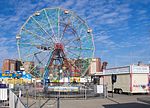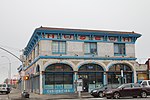Coney Island Cyclone

The Coney Island Cyclone (also known as the Cyclone) is a wooden roller coaster at Luna Park in Coney Island, Brooklyn, New York City. Designed by Vernon Keenan, it opened to the public on June 26, 1927. The coaster is on a plot of land at the intersection of Surf Avenue and West 10th Street. The Cyclone reaches a maximum speed of 60 miles per hour (97 km/h) and has a total track length of 2,640 feet (800 m), with a maximum height of 85 feet (26 m). The coaster operated for more than four decades before it began to deteriorate, and by the early 1970s the city planned to scrap the ride. On June 18, 1975, Dewey and Jerome Albert, owners of the adjacent Astroland amusement park, entered into an agreement with New York City to operate the ride. The roller coaster was refurbished in the 1974 off-season, and reopened on July 3, 1975. Astroland Park continued to invest millions of dollars in the upkeep of the Cyclone. After Astroland closed in 2008, Cyclone Coasters president Carol Hill Albert continued to operate it under a lease agreement with the city. In 2011, Luna Park took over operation of the Cyclone. The coaster was declared a New York City designated landmark on July 12, 1988, and was placed on the National Register of Historic Places on June 26, 1991.
Excerpt from the Wikipedia article Coney Island Cyclone (License: CC BY-SA 3.0, Authors, Images).Coney Island Cyclone
West 10th Street, New York Kings County
Geographical coordinates (GPS) Address External links Nearby Places Show on map
Geographical coordinates (GPS)
| Latitude | Longitude |
|---|---|
| N 40.574166666667 ° | E -73.977777777778 ° |
Address
Coney Island Cyclone
West 10th Street
11224 New York, Kings County
New York, United States
Open on Google Maps









